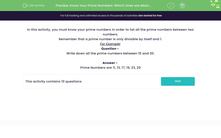In this activity, we will be testing our knowledge of prime numbers in order to list all the prime numbers between two numbers.
Remember that a prime number is only divisible by itself and 1. It has exactly two factors.

Example
Write down all the prime numbers between 10 and 30.
Answer
Prime numbers have only two factors - the number 1 and the number itself.
We can immediately remove all the even numbers as possible prime numbers because they all have the number 2 as a factor.
So we can remove 12, 14, 16, 18, 20, 22, 24, 26 and 28.
That leaves us with 11, 13, 15, 17, 19, 21, 23, 25, 27 and 29 as possible contenders.
15 is not a prime number because it has 3 and 5 as its factors: 3 x 5 = 15
21 is not a prime number because it has 3 and 7 as its factors: 3 x 7 = 21
25 is not a prime number because it has 5 as a factor: 5 x 5 = 25
27 is not a prime number because it has 3 and 9 as its factors: 3 x 9 = 27
That leaves us with: 11, 13, 17, 19, 23 and 29 as the prime numbers between 10 and 30.
All of those numbers have only two factors.

Let's have a go at some questions now.








